Introduction:
Motorized bridge construction is rising since it reduces labor intensity, speeds up timelines, and boosts product quality. This pattern encompasses most construction methods and is visible in various countries. Designers are experimenting with various materials to generate new kinds of attention. Many hands are usually needed when deciding how to utilize natural resources best. Determining the significance of specific measures regarding material selection might lead to more efficient use of primary resources. Companies that specialize in bridge construction utilize a wide variety of materials.
Stones, wood, and steel have been used to make bridges for a long time. More recently, reinforced and pre-stressed concrete has also been used. Aluminium and its alloys and a few types of plastic are used for easy things. These materials vary in how strong and easy they work and how resistant they are to rust. They are also different in how they are made, how they look, and what colors and surfaces can be used to make different effects. For spans, the best material to use is the one that makes the best bridge in terms of shape, quality, cost, and fit with the surroundings.
Types of Materials Used in Bridge Construction:
1. Concrete:
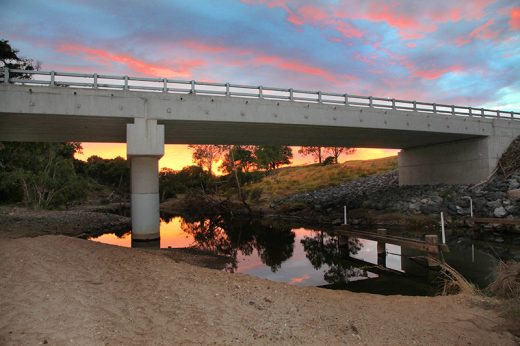
Fig1: Concrete Bridge
Courtesy: todconsulting.com
Concrete continues to be the material of choice for bridge construction worldwide because of widespread belief in the material’s performance and longevity. Concrete bridges’ final form and building processes are difficult to match compared to other materials. Concrete is the best building material for any bridge project, regardless of size, shape, or intended purpose, because of its durability, aesthetics, economical solutions, streamlined construction, and rapid deployment procedures. The numerous varieties of concrete are readily available across the country to provide construction flexibility, making concrete a versatile resource that can be used on even the most difficult bridge types or construction sites.
Concrete’s versatility in structural form means that designers can create beautiful bridges that fit in perfectly with their environments. No of the size of the project, concrete may be used to create beautiful, sturdy, and functional structures. Architectural surface finishes can improve aesthetics and reduce upkeep by doing away with the need for cladding painting, and other common maintenance tasks.
2. Steel:
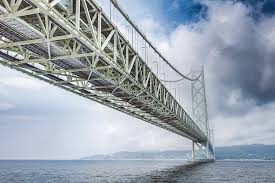
Fig2: Steel Bridge
Courtesy: steelfabservices.com.au
In comparison to other materials, steel’s strength increases significantly. Because of this, greater-span bridges may be built using it. As we all know, steel is an alloy of iron and various other elements, the most important of which is carbon. The qualities of a substance are modified according to the kind, concentration, and arrangement of its constituent parts. The altered composition affects the material’s tensile strength, flexibility, and hardness. Steels used in regular construction may withstand loads of several hundred mega Pascal. It is over ten times stronger than regular concrete’s compressive and tensile strengths. Steel’s flexibility is its most outstanding inherent quality. It is the extent to which an object can be deformed before it breaks. This quality of steel is a vital consideration in building design.
3. Stone:
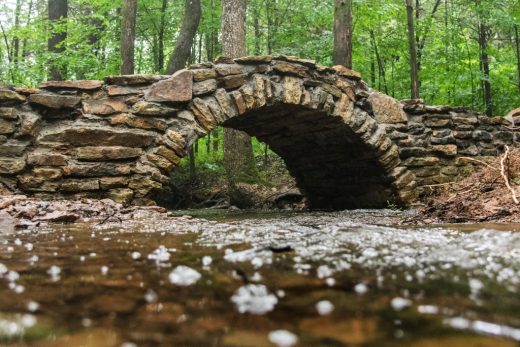
Fig3: Stone Bridge
Courtesy: instructables.com
Stone is resistant to force when compressed and to a lesser extent when sheared but offers little resistance when stretched. Because of this, brick arch bridges are intended to be under compression all the time. Each arch is built atop a temporary centering or falsework structure. Compression arch bridges were initially designed to have a central keystone that supported the entire structure. The bridge’s strength increased as more vehicles crossed it. Evidence shows that stone bridges were used tens of thousands of years ago. Clapper bridges served as the inspiration for the first surviving stone buildings. These are an ancient type of stone bridge made from massive flat slabs of granite or schist supported by other stones or rest on the sides of rivers and streams.
Masonry arch bridges appear to cost about the same as concrete or steel bridges, although their construction costs are predicted to be much higher. It is because there is no requirement for high-priced equipment or machinery. Masonry bridges have traditionally been built using manual work and basic lifting tools. If properly maintained, Masonry bridges can outlast any other bridge type and have much lower life-cycle maintenance costs than other bridge types.
4. Timber or Wood:
When choosing between timber and wood for bridge construction, it’s important to note that timber is a type of wood. Timber refers to wood specifically processed and prepared for structural applications, including bridge construction. However, we can discuss the differences if you’re referring to timber as solid, sawn timber, and wood as a more general term encompassing various wood products.
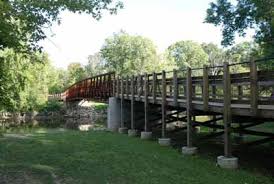
Fig4: Timber Bridge
Courtesy: instructables.com
Timber has been used for centuries in bridge construction as a building material due to its natural strength, durability, and availability. It is often preferred for smaller bridges, pedestrian bridges, or in rural areas where timber resources are abundant. Timber bridges can be constructed using solid-sawn timber or engineered timber products such as glued laminated timber (glulam) or laminated veneer lumber (LVL). These engineered products offer enhanced strength and dimensional stability compared to solid-sawn timber.
On the other hand, wood is a broader term that includes various forms and types of wood products, such as timber, plywood, and composite materials. In modern bridge construction, wood is often combined with other materials, such as steel or concrete, to create hybrid structures. For example, a bridge may have a concrete or steel substructure, using wood for the deck or aesthetic elements.
The choice between timber (wood) and other materials for bridge construction depends on several factors, including:
(i) Span and load requirements: Timber bridges are typically suitable for shorter spans and lighter loads than steel or concrete bridges.
(ii) Environmental conditions: Wood is susceptible to decay, insect damage, and weathering, so the bridge’s location and exposure to moisture and sunlight must be considered. Proper treatment and maintenance can mitigate these issues.
(iii) Aesthetics: Wood bridges can offer a natural and visually appealing look, which may be desirable in certain settings.
(iv) Cost: Timber bridges can be cost-effective compared to other materials, especially for shorter spans.
5. Cast Iron:
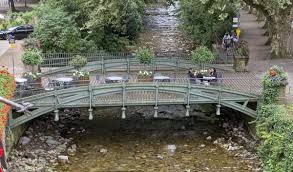
Fig5: Cast Iron Bridge
Courtesy: structurae.ne
Cast iron has been historically used in bridge construction due to its durability, strength, and ability to withstand heavy loads. However, it is important to note that the use of cast iron in modern bridge construction has significantly diminished over the years, primarily due to the advent of stronger and more cost-effective materials such as steel and concrete. Cast iron was commonly used to construct bridges during the 19th and early 20th centuries, particularly for arch and truss bridges. The material’s high compressive strength made it suitable for supporting the weight of the bridge structure and the traffic loads it would bear. Cast iron was also favored for its resistance to fire, making it a reliable choice for bridges.
However, there are certain limitations to the use of cast iron in bridge construction. Cast iron is brittle and lacks the elasticity and tensile strength required to withstand the dynamic forces experienced by modern bridges, such as wind loads and heavy traffic. It is also prone to corrosion, which can significantly reduce its structural integrity over time. These drawbacks have led to a shift towards using materials like steel and concrete, which offer superior strength, elasticity, and durability.
6. Composite Materials:
Composite materials have gained significant popularity in bridge construction due to their exceptional strength, durability, and lightweight characteristics. Here are some commonly used composite materials in bridge construction:
(i) Fiber-Reinforced Polymers (FRPs): FRPs consist of a polymer matrix, such as epoxy or polyester, reinforced with high-strength fibers, such as carbon, glass, or aramid fibers. They offer a high strength-to-weight ratio and corrosion resistance and are easy to fabricate. FRPs are typically used in bridge decks, reinforcing bars, and cable-stayed bridge systems.
(ii) Fiber-Reinforced Concrete (FRC): FRC is a composite material that incorporates fibers, such as steel or synthetic fibers, into the concrete mix. Adding fibers enhances concrete’s tensile strength and crack resistance, improving performance and durability. FRC is commonly used in bridge decks, girders, and precast elements.
(iii) Carbon Fiber-Reinforced Polymer (CFRP) Composites: CFRP composites are made by embedding carbon fibers in a polymer matrix, such as epoxy resin. These composites exhibit high strength, low weight, and excellent fatigue resistance. CFRP composites are often used in bridge strengthening and rehabilitation projects, where they are applied externally to existing structures to enhance their load-carrying capacity.
(iv) Glass Fiber-Reinforced Polymer (GFRP) Composites: GFRP composites consist of glass fibers embedded in a polymer matrix, typically epoxy or polyester resin. They offer good mechanical properties, electrical insulation, and resistance to chemical corrosion. GFRP composites find applications in bridge decks, bridge railings, and reinforcement of aging structures.
(v) Hybrid Composites: Hybrid composites combine different types of fibers or matrices to achieve specific performance requirements. For instance, combining carbon and glass fibers can balance strength and cost. Hybrid composites are employed in various bridge components, including girders, cables, and tension members.
7. Pre-stressing Concrete:
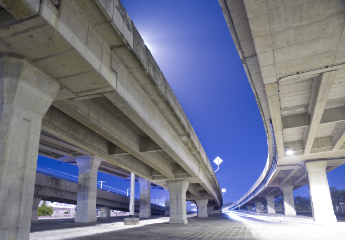
Fig6: Pre-stressing Concrete
Courtesy: structurae.ne
Pre-stressing concrete bridges involves extending cement footers with longitudinal openings for steel ligaments (links or bars) as with built-up concrete. However, the openings for the ligaments are curved vertically from one end to the other, and the ligaments are then lengthened and secured at the ends. The tendons, already under much stress, pull the two closed doors together, putting pressure on the bar.
Also, the curved ligaments exert a vertical force, and the designer can use this vertical force to cancel out a large part of the low load that the pillar is supposed to carry. Pre-stressed-on concrete reduces the amount of steel and cement needed for a building. It makes plans lighter and often cheaper than plans for built-up concrete.
Conclusion:
Bridge construction involves using various materials depending on the bridge type, span length, load capacity, environmental conditions, and budget. It’s important to note that the selection of materials depends on the specific project requirements and engineering considerations. Designers and engineers carefully evaluate load-bearing capacity, environmental conditions, aesthetics, longevity, and cost-effectiveness to determine the most suitable materials for a bridge construction project.
References:
1. Different types of materials used in Bridge Construction. (2020, December 12). Constro Facilitator. https://constrofacilitator.com/different-types-of-materials-used-in-bridge-construction/
2. Different Types Of Materials Used In Bridge Construction In 2022 | SIMEX. (2021, June 30). SIMEX Bangladesh. https://simex.com.bd/different-types-of-materials-used-in-bridge-construction/
3. Dhakar, R. (2022, March 4). Materials Used for Bridge Construction – Civil Engineering Panel. Civil Engineering Panel. https://civilpanel.com/materials-used-for-bridge-construction/
4. Valle, G., & of Giovanni Valle’s posts., V. A. (2020, November 28). 4 Best Materials for Building Bridges – BuilderSpace. BuilderSpace. https://www.builderspace.com/4-best-materials-for-building-bridges
5. Aull, J. (2021, December 28). Building Materials for Bridges – Nature Bridges. Nature Bridges. https://www.naturebridges.combuilding-materials-for-bridges/
6. Bridge – Reinforced, Prestressed Concrete, Plate Girders, and Caissons. (n.d.). Encyclopedia Britannica. https://www.britannica.com/technology/bridge-engineering
If you have a query, you can ask a question here.


